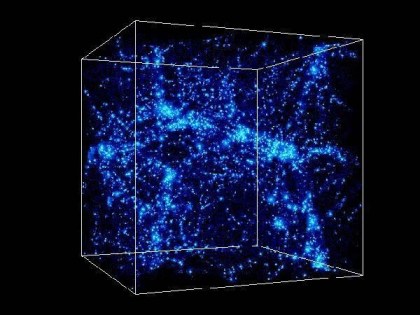Newton´s Theory of Gravitation
Gravitational potential (singularity) of point mass and Newton’s law of gravitation.
Newton’s theory of gravitation connects the gravitational potential P(x) at the position x with a point mass m(y) at position y by the relation
- (1) P(x) = G m(y) / |x-y|
where G is a gravitational constant. This formula is normally read as expressing that the mass point m(y) at y by action at distance generates a gravitational potential P(x) and associated gravitational force at x but the mechanism for the action at distance was not explained by Newton and is still unknown.
Spiral galaxies and hen with egg
More generally, the relation between a gravitational potential P(x) and a corresponding mass distribution m(y) can be expressed as an integral equation obtained by summation/integration in (1) of the form
- (2) P(x) = integral G m(y) / |x-y| dy
or alternatively as a differential equation of the form (with G=1)
-
(3) – Laplace P = m or m = – Laplace P
where Laplace is the Laplace differential operator or Laplacian (divided by 4pi). The relation between mass distribution m and gravitational potential P can be interpreted in two ways:
- HenfromEgg: the mass m defines P by the integral eq. (2) based on global integration
- EggfromHen: the potential P defines m by the differential eq. (3) based on local differentiation
where we think of the mass as Egg and the potential as Hen. We now consider these cases separately:
Hen from Egg
This is the conventional approach with the mass generating the gravitational potential and force by action at distance in a process of integration adding up the contributions from the mass distribution. As indicated, the main difficulty with this point of view is the nature of the action at distance.The action is supposedly being transmitted by a hypothetical particle named
- graviton: theoretical gauge boson that mediates the (extremely weak) gravitational interactions between particles; the quantum of the gravitational field, having zero rest mass and a spin of 2.
But nobody seems to know anything about the nature of gravitons, and how they transmit gravitation and how fast.
Egg from Hen
This is the alternative approach, where the mass is derived from the gravtitational potential by local differentiation. In this case there is no global integration with action at distance involved.
Further, one can interprete a point mass m(y) as appearing if the potential P(x) has a singularity at the point y accoring to (1). The potential would then appear like a Hen laying a point mass Egg wherever the potential has a point singularity. One could then imagine that such strong singularities of the potential would correspond to visible matter while variations of the potential without singularities would correspond to dark matter.
It is probably simpler to explain how a hen can lay an egg, than to explain how a hen can be created from an egg. Similarly it may be simpler to somehow comprehend that a potential can create a mass distribution, than to explain how a mass by action at distance can create a potential. You may argue that one can see a (concentration of) point mass(es), like the Sun, but one cannot see its gravitational potential, only notice its presence. This wold be like being able to see an egg, but not the hen, only notice its presence by e.g. sound. You could then argue that what you can see must come first, which would indicate HenfromEgg. But is such an argument scientific? Does it only depend on our eyes, and are there other eyes which can see gravitational potentials? Is the apparent action at distance only an illusion, like a person seen at distance appearing to be smaller than real size?
A cosmological model in the form of the Euler equations for a compressible gas with gravitation is formulated in Many-Minds Relativity. In this model the mass density is replaced by the gravitational potential as primary unknown, and the Euler equations expressing conservation of mass, momentum and energy are formulated in terms of gravitational potential, momentum and energy. Computational simulations with this model will be presented shortly.
Galaxy Rotation Problem
In 1959 the astronomer Vera Rubin discovered that a spiral galaxy does not spin as expected according to Newton´s gravitational law stating that the speed should decay as the inverse square-root of the distance to the center of the galaxy, assuming most of the mass is located in a galactic bulge at the center. This prediction follows directly from the fact that the centripetal accelleration of a mass moving in a circular orbit of radius R with speed V is equal to V2/R, while the gravitational force scales like 1/R2 . Rubin found that the speed is roughly constant, which would fit with a gravitational force scaling instead as 1/R. Such a gravitational force corresponds to a two-dimensional Laplacian with potential
- P(x) = m(y) G log (|x-y|)
which would correspond to a form of cylindrical potential distribution perpendicular to the visible galaxy disc with a r log(r) singularity in the distance r to the disc. Such potential distributions would resemble vortex filaments with a kink singularity creating the disc as suggested above. Possibly a cylindrical potential can replace a black hole in the center of the disc.
Speculation
Of course, the above is just a free speculation, but so seems everything relating to dark matter, dark energy,black holes, formation of galaxies and the nature of gravitation.
Over time, matter pulls together into a web-like structure along a scaffolding of dark matter (Center for Cosmological Physics/U Chicago)






